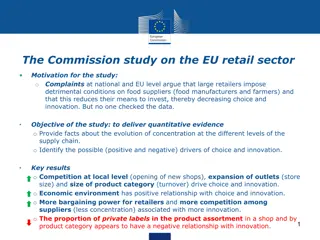Understanding the Importance of Innovation Policy in Economic Growth
Nations implement innovation policies to drive long-term economic growth by enhancing their innovation ecosystems. These policies vary from industrial policy and technology policy, aiming to support key industries, technologies, and firms. Addressing market failures like inability to capture full benefits and high risks, innovation policy plays a crucial role in fostering innovation activity and improving living standards.
Download Presentation

Please find below an Image/Link to download the presentation.
The content on the website is provided AS IS for your information and personal use only. It may not be sold, licensed, or shared on other websites without obtaining consent from the author. Download presentation by click this link. If you encounter any issues during the download, it is possible that the publisher has removed the file from their server.
E N D
Presentation Transcript
Why do nations innovation policy? From: Atkinson and Ezell, Innovation Economics , chapter 5
Innovation as the key driver of improving living standard (not capital or saving accumulation) Innovation drives a country s long run economic growth Many countries recognize that. Innovation policy differs from Industrial Policy (and also from technology policy). Free market ideologues blur that difference!
The innovation policy continuum Leave it principle to free market Support factor conditions (e.g. science, skills) Support key broad industries/technologies (e.g. batteries) Pick specific firm/industries/technologies ( picking winners / industrial policy)
Innovation policy = Enhancing the strenght if a nation innovation ecosystem Business innovate with the help of many other institutions public policy can either spur or retard the innovation activity of companies. E.g. the US support for batteries technology (as key to the clean economy .)
10 Specific innovation related (free)market failures Innovation markets are not like markets for commodities! when it comes to innovation systems, the very concept of market failure is a faulty one
1) Bacause individual firms and enterpreneurs cannot capture all he benefits of their innovative activity. They will produce less innovation activity than sociery needs. Apple iPad (today not only Apple tablets!) Knowledge not contained in one single firm; Spill over to other firms and individuals (externalities) On average, returns to society from corporate R&D is double than the return to company! Rationale for R&D Tax credit (It is not possible protect everythingh throuigh IRPs)
2) High level of risk, expense and differing time horizons, stifle the devolpment of complex new technology platforms. Even rational companies are reluctant to invest in next- generation technologies DARPA (Defence Advanced Research Project Agency) supported initial development of the Internet It helped coordinate reserch; created interoperability standards; etc. It can be that government invest in unwise projects (as the market sometimes!); sometime it is a matter of vast level of uncertainty .. Businesses often need shared infratechnologies (es. messurement methods, process control techniques, science/engeneering data, etc) that deliver substantial economic benefits
3) Capital market failures have caused private financing of R&D to shift away from innovation- based and enterpreneurial efforts. Private savings (investment) is often misallocated Investors can deal wity risk but not with uncertainty (linked to innovation). Capital shift away from more enterpreneurial and early stage research effort (short term returns targets) And long term stakeholders? Long term returns for society?
4) Coordination failures undermine the innovation process Firms cannot maximize innovation workin in isolation (networks; co-opetition; etc Patterns of cooperation are far from being optimal (e.g. duplication of reserach) The DARPA case: they played an instrumental role in identifying emerging research directions in the research communities and coordinated scientists/seed capitals, etc.) Need of Aligning interests (e.g. academy and industry have different utility functions and targets )
5) Chicken-or-egg challenges inhibit development of technology platforms Succesfull innovation depend on others (e.g Apple iPod, coordinating music licencing and broadband internet with hingh returns to everyone!) Market tend to be poor at coordinating action when multiple parties need to act togheter sinergically Chicken-or egg challenges around technology platforms (e.g. Near Field Communication NFC, enabled mobile payments, Intelligent Transport Systems; Smart Electric Grid, etc.) Critical mass is required! A wide range of actors has to act simoultaneously to develop the market! Government can provide key inftastructures and the market can innovate on top of it
6) Many industries and firms lag in adopting proven technologies Many industries and firms lag behind in technology (already available) adoption (thus impeding faster productuivity sectoral growth) Principal/Agent problem; innovation hurts the innovator itself worker and manager are the same person! Risk of cannibalizing their job; and they control entry barrier - the marketplace (clients, legal codes, etc.) market fragmentation problem; e.g. extreme atomistic structure (inefficiency) of health-care or construction industries, due to the low ability by demand to require quality (only occasional buying)
7) The innovation-producing benefits of industry clusters are under-realized Industry spatial clustering enables firm to to take advantage from common resources (in particular in industries relying on teh creation or the use of new knowledge (Techn. Transfer). Cluster exeternalities are the rationale for public intervention
8) There is mor than one equilibrium at which economies can settle, and by definition, one of them is worse from a societal perspective Multiple equilibriums can exist and markets can select the (socially) inferior one. If there are not skilled workers, firms do not adopt advanced technologies, workers do not seek-out for skills needed ( poverty traps )
9) The interest of geographically mobile firms in locating innovative activity may diverge from those of a nations residents A failure from the citizen point of view! The responsability of elected officials is to maximize the real economic welfare of citizens (not theoretical global market allocation)
10) There can be a market failure from growth itself (!) Growth is not only a matter of money ; it generates social externalities (e.g. less political tensions, tolerance, etc.) Links between low growth and political dark periods























